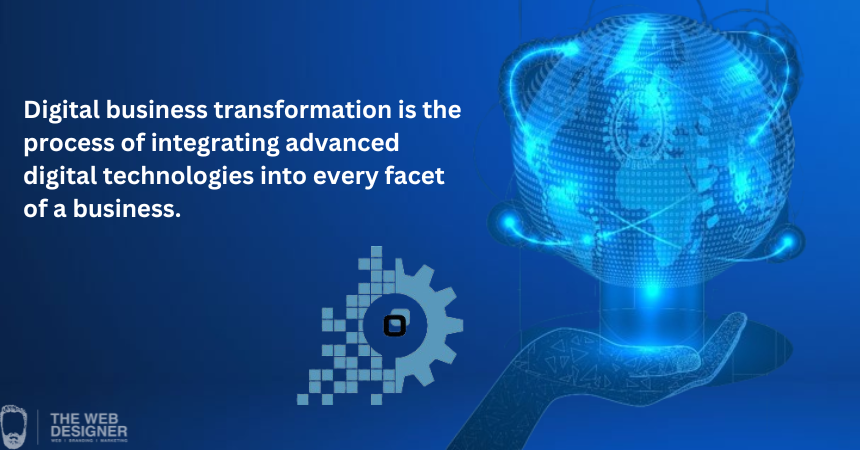Digital Business Transformation: How Digital Marketing and Website Design Can Help Your Business Succeed with The Web Designer Cardiff
In today’s fast-paced digital world, businesses need to embrace transformation to stay competitive. Digital business transformation, which includes leveraging digital marketing and website design, plays a crucial role in this journey. The Web Designer Cardiff provides expert services in Web Design Cardiff, Web Design Caerphilly, Web Design Penarth, Web Design Newport, and Web Design Barry, helping businesses enhance their online presence and achieve growth. Let’s explore how digital marketing and web design contribute to business success.
Why Digital Business Transformation Matters?
 Digital business transformation refers to integrating digital technologies into all aspects of a business. This transformation is more than just adopting new tools; it involves a cultural shift towards innovation, agility, and customer-centricity. Here are some reasons why digital business transformation is vital.
Digital business transformation refers to integrating digital technologies into all aspects of a business. This transformation is more than just adopting new tools; it involves a cultural shift towards innovation, agility, and customer-centricity. Here are some reasons why digital business transformation is vital.
Meeting Customer Expectations: Modern customers expect seamless, personalized experiences across various platforms. Businesses need to adapt to these expectations to stay relevant and competitive.
Staying Competitive: Digital technologies have made it easier for new players to enter the market, disrupting traditional business models. Embracing digital transformation helps businesses stay ahead of the competition.
Data-Driven Insights: Digital tools enable businesses to collect and analyze data, leading to informed decision-making and optimization of operations and marketing strategies.
Fostering Agility and Innovation: Digital transformation promotes a culture of agility and innovation, allowing businesses to quickly adapt to changing market conditions and customer needs.
Cost Efficiency: Implementing digital technologies can streamline processes, reduce overheads, and improve profitability.
Leveraging Digital Marketing for Business Growth
 Digital marketing is a key component of digital business transformation, offering businesses the tools to reach, engage, and convert customers effectively. Here’s how digital marketing can drive business growth:
Digital marketing is a key component of digital business transformation, offering businesses the tools to reach, engage, and convert customers effectively. Here’s how digital marketing can drive business growth:
Enhancing Online Presence: A strong online presence is critical for success. Through Web Design Cardiff, Web Design Caerphilly, Web Design Penarth, and other local services, businesses can optimize their websites and increase brand visibility.
Targeted Campaigns: Digital marketing allows for precise targeting of customer segments, delivering personalized and relevant messages that improve engagement and conversion rates.
Building Customer Relationships: Platforms like social media and email marketing enable businesses to build and maintain meaningful relationships with customers, fostering loyalty and trust.
Measuring Performance: Digital marketing provides measurable results, allowing businesses to track performance in real-time and make data-driven adjustments to their strategies.
Scaling Efforts: Digital marketing offers scalable solutions, enabling businesses to adjust their marketing efforts according to their needs and budget.
The Impact of Web Design on Business Success

A well-designed website is a cornerstone of digital business transformation. It serves as the digital face of a business and significantly impacts user experience and business outcomes. Here’s how web design contributes to business success:
User Experience (UX) Design: Websites should offer a seamless and intuitive user experience. Services like Web Design Cardiff and Web Design Penarth focus on creating user-friendly websites that enhance satisfaction and increase conversions.
Responsive Design: With the rise in mobile device usage, having a responsive website is essential. Web Design Caerphilly and Web Design Newport provide responsive designs that ensure a consistent user experience across all devices.
Branding and Visual Appeal: A website should reflect the brand’s identity and values. Web Design Barry and other local services emphasize creating visually appealing websites that build trust and credibility.
Content Optimization: Effective web design includes a well-thought-out content strategy that engages visitors and drives organic traffic through optimized content.
Effective CTAs: Strategically placed calls-to-action (CTAs) on a website can significantly increase conversions and revenue.
Choosing The Web Designer Cardiff for Your Transformation Needs

When it comes to digital business transformation, The Web Designer Cardiff offers expertise in web design and digital marketing, tailored to meet the unique needs of your business. Here’s why you should choose The Web Designer Cardiff:
Expertise in Local Markets: With specialized services in Web Design Cardiff, Web Design Caerphilly, Web Design Penarth, Web Design Newport, and Web Design Barry, The Web Designer Cardiff understands the local market dynamics and customer preferences.
Innovative Solutions: The Web Designer Cardiff provides cutting-edge web design solutions that are modern, responsive, and tailored to your business needs.
High-Quality Services: As a premier web design agency, The Web Designer Cardiff delivers high-quality services that enhance your online presence and drive business growth.
Customer-Centric Approach: The Web Designer Cardiff focuses on creating user-friendly websites that offer an exceptional user experience, helping you build strong relationships with your customers.
Comprehensive Digital Marketing: In addition to web design, The Web Designer Cardiff offers comprehensive digital marketing services that help you reach and engage your target audience effectively.
Transform Your Business with The Web Designer Cardiff
Digital business transformation is no longer optional; it is essential for businesses aiming to thrive in today’s digital landscape. Leveraging digital marketing and web design can significantly enhance your online presence, engage customers, and drive business growth. The Web Designer Cardiff, with its expertise in Web Design Cardiff, Web Design Caerphilly, Web Design Penarth, Web Design Newport, and Web Design Barry, is your trusted partner in this transformation journey. Embrace digital business transformation today and set your business on the path to success

